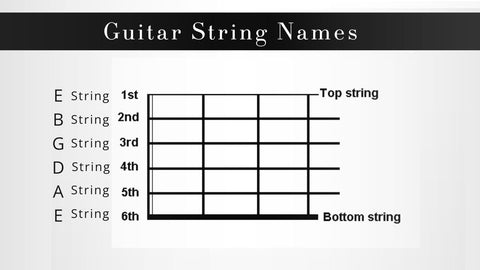Mastering Guitar String Names: A Beginner's Guide

Learning to play the guitar is an exciting journey filled with discovery and creativity.
However, before diving into chords and melodies, it's essential to familiarize yourself with the basics, including the names of the guitar strings.
In this beginner's guide, we'll explore the fundamentals of guitar string names, their significance, and tips for mastering them.
Understanding the Anatomy of a Guitar:
Before delving into the string names, let's take a moment to understand the basic structure of a guitar. A typical guitar consists of six strings, each producing a different pitch when plucked or strummed.
These strings are stretched along the length of the guitar's neck and are tuned to specific notes.
The Standard Tuning:

The standard tuning for a guitar is EADGBE, with each letter representing the name of a string when played open (without pressing down any frets). Starting from the thickest string to the thinnest, the string names are as follows:
1. E String (6th String): The thickest string on the guitar is the low E string. When played open, it produces the lowest pitch among all the strings.
2. A String (5th String): Moving towards the thinner strings, the next string is the A string. When played open, it produces a pitch higher than the E string.
3. D String (4th String): Following the A string is the D string. It produces a higher pitch than the A string when played open.
4. G String (3rd String): The next string in line is the G string. It produces an even higher pitch when played open.
5. B String (2nd String): Moving towards the thinnest strings, we have the B string. It produces a higher pitch compared to the G string.
6. High E String (1st String): Finally, the thinnest string on the guitar is the high E string. When played open, it produces the highest pitch among all the strings.
Mnemonic Devices for Remembering String Names:
For beginners, remembering the names of the guitar strings can be challenging at first. However, mnemonic devices can make the process easier. Here are a few popular mnemonics:
- Eddie Ate Dynamite, Good Bye Eddie: Each word represents the first letter of the string names in order (E, A, D, G, B, E).
- Every Acid Dealer Gets Busted Eventually: Another mnemonic using the first letter of each string name.
Importance of Learning Guitar String Names:
Understanding and memorizing the names of the guitar strings is crucial for several reasons:
1. Tuning: Knowing the string names is essential for tuning your guitar accurately. Whether using a tuner or tuning by ear, recognizing the string names helps ensure each string is tuned to the correct pitch.
2. Chord Formation: When learning chords, knowing the string names helps in understanding chord diagrams and finger positioning. It allows you to navigate the fretboard more effectively and play chords with precision.
3. Communication: Whether discussing guitar techniques with other musicians or seeking guidance from instructors, knowing the string names facilitates clear communication within the guitar community.
Practical Tips for Memorizing String Names:
Memorizing the names of the guitar strings may take some time and practice. Here are a few tips to help you master them:
1. Repetition: Practice saying the string names aloud while tuning your guitar or during practice sessions.
2. Visual Aids: Utilize diagrams or charts that display the string names and their corresponding pitches.
3. Incorporate Them Into Practice: As you learn new chords or songs, refer to the string names regularly. Visualize the strings as you play to reinforce your memory.
4. Create Mnemonics: Develop mnemonic devices or word associations to aid in memorization.
Conclusion:
Mastering the names of the guitar strings is a fundamental step in your journey as a guitarist. By understanding the string names and their significance, you'll not only enhance your ability to play the guitar but also improve your overall musical comprehension.
With patience, practice, and the tips provided in this guide, you'll soon become fluent in navigating the fretboard and creating beautiful music. Happy strumming!
Also Read: A Beginner's Guide to Acoustic Guitars
